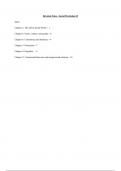Revision Notes - Social Psychology II
Index
Chapter 2: The self in Social World - 1
Chapter 5: Genes, culture, and gender - 4
Chapter 6: Conformity and obedience - 4
Chapter 7: Persuasion - 7
Chapter 9: Prejudice - 11
Chapter 11: Emotional behaviors and interpersonal relations - 16
, 1
CHAPTER 2: The self in a Social World (23-51)
- Self–concept: Who am I?
- What is the nature and motivating power of self-esteem?
- What is self-serving bias?
- How do people manage their self-presentation?
● Spotlight effect: intuitively overestimating the extent to which other’s attention is aimed at us
● Illusion of transparency: illusion that out concealed emotions leak out and can be easily read
by others
○ Both illustrate the interplay between our self of self and social world
■ Social surroundings affect our self-awareness (ex: when we are differ from
the rest in some way)
■ Self-serving bias ( attribute success to internal factors, attribute failure to
external)
■ Self-concern motivates our social behavior (in attempt to make positive
impression, we adjust behavior depending on the expectations of others)
■ Social relationships define our sense of self (we might act in a different way
with our parents than with our friends/ breakup can change our self-concept)
● Self concept: what we know and believe about ourselves
● Self-schemas: beliefs about self that organize and guide the processing of self-relevant
information
○ How we see ourself affects how we perceive, remember, evaluate other people &
ourselves
○ Self-schemas create our self concepts (they are part of it)→ help us organize &
retrieve our experiences
● Social comparisons: evaluating one’s opinions and abilities by comparing oneself with others
○ Tend to do most of the time
○ Sometimes based on incomplete information (instagram)
○ Social comparison can diminish (limit) our satisfaction (in case of success, -
comparing to someone else who have a bigger success → makes us less happy-
“comparing upward”
● “The looking glass self” - imagining how other perceive me and then using it for self
perception
● Individualism (prevalent in Western countries)
○ Priority on
■ Becoming self-contained: independent, autonomous, self-reliant
■ One’s own goals over group’s goals
■ Defining one’s identity in terms of personal attributes rather than group
identifications
○ Self-esteem: personal, less rational
■ If threatened - tend to get angry/ sad
■ In case of failed task: are more likely to not try again/ persist (due to the fact
that task performance reflects self-image thus - failed task threatens
self-image)
● Collectivism (prevalent in Asia, Africa, Central & South America)
, 2
○ Priority on
■ Respecting & identifying with the group (groups’ attributes & characteristics)
■ Goals of the group, social connections, interdependence
■ Less positive views on one’s own work (people tend to be more self-critical)
■ Greater sense of belonging & more integration between self and others
○ Self-esteem: tends to be low, malleable (depends on the context - changes, not stable)
■ In case of failure: persist/ try again
■ Comparison as a way to facilitate self-improvement
● Cultures become more individualistic over time
● Planning fallacy: tendency to underestimate how long it will take to complete a task
Predicting our feelings
● Most difficult to predict the intensity & duration of future emotions
● Impact bias: overestimating the enduring impact of emotion-causing events (thinking that a
specific event will give us lasting emotions)
○ Especially after negative events
● Dual attitude system: differing implicit (automatic) and explicit (consciously controlled)
attitudes towards the same object.
○ Verbalized explicit attitudes can change with education and persuasion
○ Implicit attitude changes slowly with practice forming new habits
■ Practical implications: self reports are often untrustworthy
Self-esteem
● Self-esteem: person’s overall self- evaluation/ sense of self worth
○ Good academic self-concept can predict good academic performance, rather than just
having general good self-esteem
■ People with high self-esteem: compensate for it (blame on external factors)
● Fosters: initiative, resilience, pleasant feelings
■ People with poor self-esteem: blame themselves/ give up
● More vulnerable to: anxiety, loneliness, depression, eating disorders,
intentional self-harm, quitting relationships
● Usually, it is a symptom of an underlying disease (trauma, tough
childhood)
● Don’t believe people saying positive things about them, prefer
understanding responses
○ Those who actively pursue their self-esteem can experience
more stress, anger, relationship problems, etc., since → less
open to criticism, too focused on showing success in
activities for the sake of impressing others, than enjoying the
activities.
● Narcissism: having inflated sense of self
● Differences:
Narcissists People with high self-esteem
- Feel they are better and smarter - Feel they are worthy & good
than others - Value both: individual achievements




